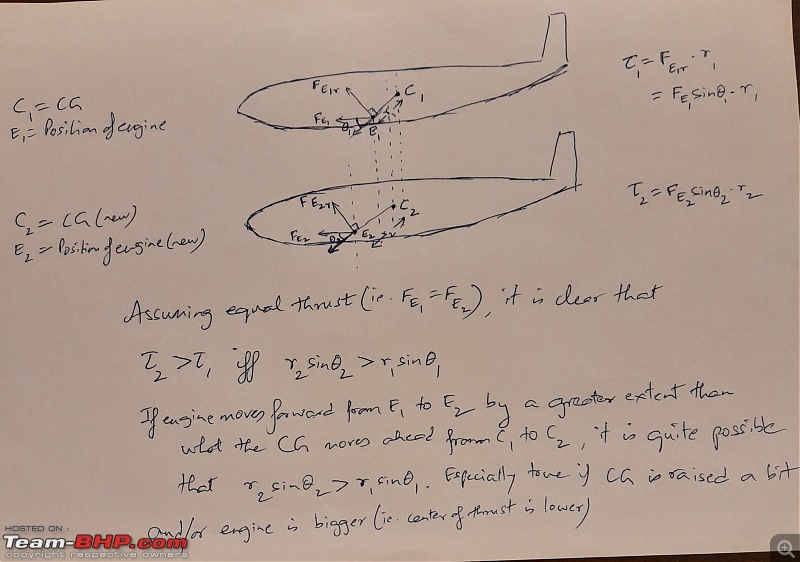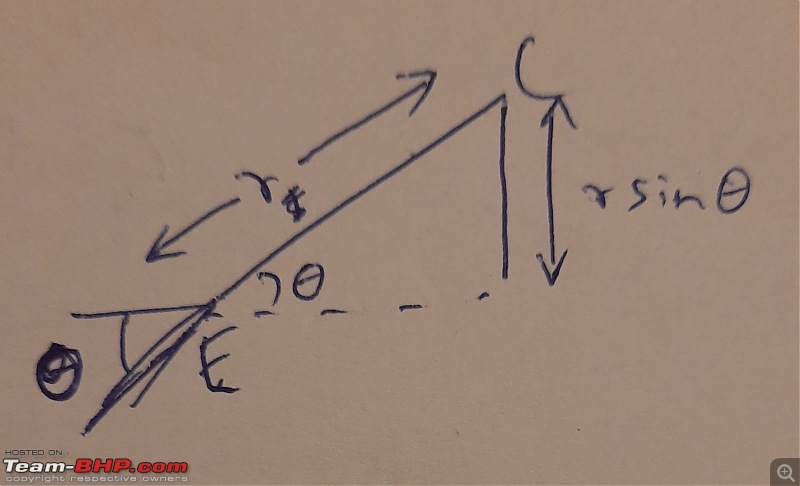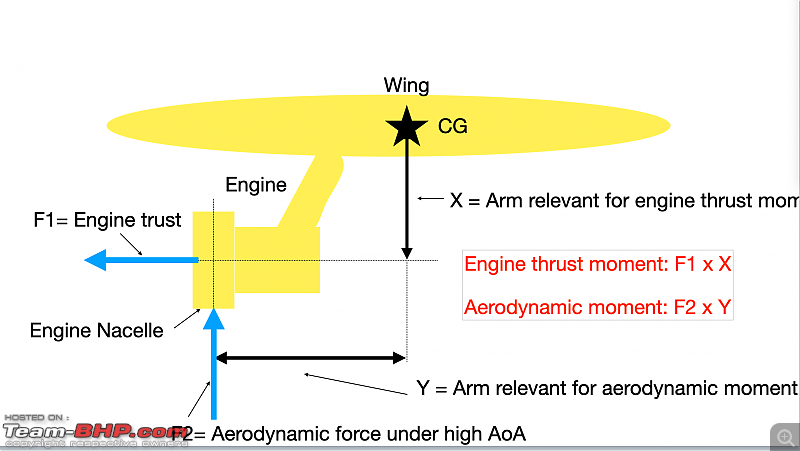
 |
|
Originally Posted by Jeroen
(Post 4799203)
No idea. But we do know that the engines are mounted higher, so the arm is shorter to start with. So if everything else is equal, for a given thrust increase it would actually be less. But that is purely based on the fact that we know the engines are mounted a little higher. No idea about other effects, or differences. Jeroen |
|
Originally Posted by arijitkanrar
(Post 4799675)
The engines are higher but also more forward mounted which means that although the thrust moment arm is shorter, the moment arm of the lift generated by the engine nacelles is actually longer. Also the moment acts longitudinally ahead of of the CoG thus causing a pitch up moment in high AoA/high speed scenarios. And these scenarios were the original scope of MCAS intervention. Remember the MCAS was origianlly intended to be a longitudinally stability enhancement. |



|
Originally Posted by vharihar
(Post 4799759)
Below is a pic I drew that I hope helps understand it better: |
|
Originally Posted by Jeroen
(Post 4799846)
The internet jumps on that as if that is logical. It is not. |
|
Originally Posted by Jeroen
(Post 4799846)
However, under high AoA, a very different force comes into play, perpendicular to engine thrust. The engine nacelle produces additional lift... ...I do imagine that F2 is actually much smaller than F1, even though I have drawn about equal length. I am not sure about X length compared to Y length, but I guess they are not that different. |
|
Originally Posted by vharihar
(Post 4799975)
..my puzzlement remains. |
|
Originally Posted by vharihar
(Post 4799975)
so the center of thrust moves up (well, it may be offset by the engine being bigger, so that may make the center of thrust move a bit down; so it will need to be seen which of the 2 opposing contributions wins and has the net effect on this "distance", or the "arm" as you call it). . |
|
Originally Posted by Jeroen
(Post 4821335)
Boeing appears to aim for recertification flight (s) by the end of the month (June). |
| Boeing has received clearance to begin test flights of its troubled 737 Max jet, a spokesperson for the Federal Aviation Administration said Sunday. The test flights of could begin as early as Monday. The move marks an important step in the process to re-certify the 737 Max, which has been grounded since March 2019, for passenger flights. Boeing has said it expects to receive full approval for the plane to fly passengers by the middle of this year. The FAA in a letter to Congress Sunday said it does not yet have a date for when the grounding will be lifted. |
| The FAA and Boeing today completed the certification flight tests on the Boeing 737 MAX. During three days of testing this week, FAA pilots and engineers evaluated Boeing’s proposed changes in connection with the automated flight control system on the aircraft. While completion of the flights is an important milestone, a number of key tasks remain, including evaluating the data gathered during these flights. The agency is following a deliberate process and will take the time it needs to thoroughly review Boeing’s work. We will lift the grounding order only after FAA safety experts are satisfied that the aircraft meets certification standards. |
|
Originally Posted by AlphaKilo
(Post 4836684)
First step towards final certification achieved. |
| For example, American Airlines previously listed the Max on its website booking page as the “7M8” aircraft, which stands for Boeing 737 MAX 8. (There are 7, 8, 9 and 10 numbered variants, depending on the seating capacity). Southwest has a webpage that lets you identify what plane you are scheduled to fly on. However, the plane that is scheduled to fly a route can change for myriad reasons, ranging from run-of-the-mill maintenance issues to poor weather causing network delays. |
| How can I tell if I’m flying on a Max? If you’re waiting at the gate and see your plane, look for large and pointy fins extending above and below the wingtips called winglets. Winglets come in all manner of similar designs, but the Max’s stand out. |
| Will airlines allow me to rebook or get a refund if I don’t want to fly on the Max? Rebook? Yes. Refund? No. U.S. carriers have not yet announced policies related to the return of service of the Max. However, in a statement this week to The New York Times, a United Airlines spokeswoman said that the company “will be transparent — and communicate in advance — with our customers who are booked to fly on a Max aircraft, will rebook those who do not want to fly on a Max at no charge.” Expect other airlines to follow United’s lead. |
| To ensure that an erroneous signal from a failed single AOA sensor does not prevent continued safe flight and landing, and specifically that it does not generate erroneous MCAS activation, the FAA proposes to require installation of updated FCC software with revised flight control laws 10 associated with MCAS. These revised flight control laws would use inputs from both AOA sensors to activate MCAS. This is in contrast to the original MCAS design, which relied on data from only one sensor at a time, and allowed repeated MCAS activation as a result of input from a single AOA sensor. The updated FCC software would also compare the inputs from the two sensors to detect a failed AOA sensor. If the difference between the AOA sensor inputs is above a calculated threshold, 11 the FCC would disable the speed trim system (STS), including its MCAS function, for the remainder of that flight, and provide a corresponding indication of such deactivation on the flight deck. To ensure that MCAS will not command repeated movements of the horizontal stabilizer, the revised flight control laws would permit only one activation of MCAS per sensed high AOA event. A subsequent activation of MCAS would be possible only after the airplane returns to a low AOA state, below the threshold that would cause MCAS activation. The updated FCC software would also limit12 the magnitude of any MCAS command to move the horizontal stabilizer, such that the final horizontal stabilizer position (after the MCAS command) would preserve the flightcrew’s ability to control the airplane pitch by using only the control column. The original design allowed MCAS commands to be made without consideration of the horizontal stabilizer position – before or after the MCAS command. An undesired MCAS activation could prompt the flightcrew to perform a nonnormal procedure. To ensure that after any foreseeable failure of the stabilizer system, safe flight is not dependent on the timeliness of the flightcrew performing a non-normal procedure, the FAA proposes multiple changes. First, as previously discussed, the flight control laws would be changed to instead use inputs from two AOA sensors for MCAS activation, so that there would not be an undesired MCAS activation due to a single AOA sensor failure that could lead a flightcrew to perform a non-normal procedure. Second, in the event that MCAS is activated as intended (i.e., during a high AOA event), the updated flight control laws software would limit the number of MCAS activations to one per high AOA event, and limit the magnitude of any single activation so that the flightcrew could maintain pitch control without needing to perform a nonnormal procedure. The FAA also proposes requiring an additional software update that would alert the flightcrew to a disagreement between the two AOA sensors. This disagreement indicates certain AOA sensor failures or a significant calibration issue. The updated MDS software would implement an AOA DISAGREE alert on all 737 MAX airplanes. Some 737 MAX airplanes were delivered without this alert feature, by error. While the lack of an AOA DISAGREE alert is not an unsafe condition itself, the FAA is proposing to mandate this software update to restore compliance with 14 CFR 25.1301 and because the flightcrew procedures mandated by this AD now rely on this alert to guide flightcrew action. As a result of the changes proposed in this AD, differences between the two AOA sensors greater than a certain threshold13 would cause an AOA DISAGREE alert on the primary flight displays (PFDs). ... ... As part of the FAA’s review of these design changes, the agency reviewed the entirety of the 737 MAX horizontal stabilizer control system. This review revealed that the physical separation of the horizontal stabilizer trim arm wiring and the horizontal stabilizer trim control wiring does not meet the criteria specified in 14 CFR 25.1707. This design standard was promulgated in 2007 and therefore is part of the certification basis of the 737 MAX but not of previous Boeing Model 737 airplanes. Certain wiring installations must have enough physical separation so that a wiring failure cannot create a hazard. Since design changes must comply with FAA regulations, the FAA proposes to require changes to the wiring installation to meet the required physical separation between the horizontal stabilizer trim arm wiring and the horizontal stabilizer trim control wiring. The FAA proposes this action to bring the airplanes into regulatory compliance. |
| Many failures of safety and envelope protection systems result in them being locked out for the rest of the flight following a sensor or computer malfunction, you normally can't dispatch without them but if they fail in flight you continue with appropriate mitigations. |
| All times are GMT +5.5. The time now is 12:34. |